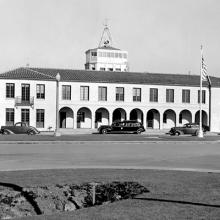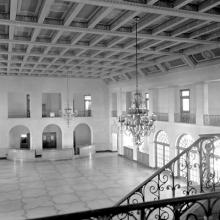Terminal 2
Terminal 2
Sky Terrace, Departures Level 4, Gallery 2D
Continuous






Administration Building at Mills Field Municipal Airport c. 1927
1993.07.11
R2019.3801.037
Securing airline operations during the early years at Mills Field was challenging. The San Francisco Chronicle described the airport as “the world’s prize mud hole,” and flight training, sightseeing, and recreational flying comprised most of the initial activity at Mills Field. Before long, larger airliners such as the venerable Ford Tri-Motor linked Mills Field with other destinations throughout California.
Charles Lindbergh and his Ryan NYP Spirit of St. Louis at Mills Field September 16, 1927
2011.134.001
R2019.3801.020
After the historic transatlantic solo flight in his Ryan NYP Spirit of St. Louis, famed aviator Charles A. Lindbergh (1902–74) made the first of many stops at Mills Field on September 16, 1927—declared “Lindbergh Day” by San Francisco city officials.
Mills Field Hangar No. 1 viewed from the north west January 13, 1928
2011.032.0042
R2019.3801.014
Hangar No. 1 was the first aircraft hangar at Mills Field, located 150 feet to the south of the administration building. The airport site was not permanently secured, and to allow for disassembly and relocation, central attach points for the hangar’s steel frame were fastened with nuts and bolts rather than rivets. Lettering on the roof identified the airport from above, while an illuminated windsock, rotating beacon, and an arrow pointing north provided weather and navigational information to approaching pilots. Three more hangars of similar size and construction were added in early 1928, and although they were conceived as temporary structures, Hangar No. 4 stood until 1999.
Administration and Terminal Building, west elevation, San Francisco Airport. November 16, 1938
1997.52.078.007
R2019.3801.039
Commercial aviation evolved into a more practical mode of transportation in the 1930s. Modern, twin-engine airliners such as the Boeing 247 and Douglas DC-3 carried passengers farther and faster than their tri-motored predecessors, finally surpassing the speed of rail service. Although fares exceeded what most of the Depression-era public could afford, major airports around the United States prepared for the future—including the newly renamed San Francisco Airport.
San Francisco Airport launched a series of major improvements, backed by funding and labor from President Franklin D. Roosevelt’s “New Deal” and the Works Progress Administration (WPA). By 1937, more than 790,000 square-feet of concrete runways, taxiways, and aircraft parking were in place, illuminated by modern, multicolored lighting and 45,700 feet of underground power lines. A new administration and terminal building was also completed that year. Designed in the Spanish Colonial Revival style, the building included a four-story control tower, restaurant, cocktail lounge, and a grand passenger waiting room with terrazzo floors and a stenciled ceiling.
Administration and Terminal Building, passenger waiting room from upper level mezzanine, San Francisco Airport July 15, 1937
1997.52.078.032
R2019.3801.040
Maxine Crookston (Schmidt) in the San Francisco Airport control tower late 1940s
Gift in Memory of Maxine Crookston Schmidt
2016.067.016
R2019.3801.034
Maxine Crookston (1915–2016) was known as “The Voice of San Francisco Airport” from the late 1940s through the 1950s. Born in Salt Lake City, Crookston dreamed of flying as a child and recalled jumping as far as possible from her parents’ porch while flapping her arms as wings. Crookston earned a B.A. at the University of Utah, an M.A. at Stanford, and taught high school English and Latin. However, her life's ambition was to fly as a commercial pilot, and Crookston acquired her private and commercial pilot's licenses with an instrument rating. During the Second World War, she served with the Civil Air Patrol as a survey pilot and with the Army Air Corps as a flight instructor. Excluded from civilian work as an airline pilot due to her gender, Crookston switched gears and was hired by the Civil Aeronautics Authority in 1942 as an air traffic controller in Salt Lake City. She transferred to San Francisco in 1946 and became the first female air traffic control watch supervisor in the country. Crookston was also a popular subject for interviews by Bay Area newspapers, radio programs, and television stations. After she married fellow pilot (and later air traffic controller) Eugene Schmidt in 1958, the couple settled in Southern California.
I got interested in air traffic controlling because of my love for aviation…Flying was complete happiness to me.
—Maxine Crookston (Schmidt), 2015





